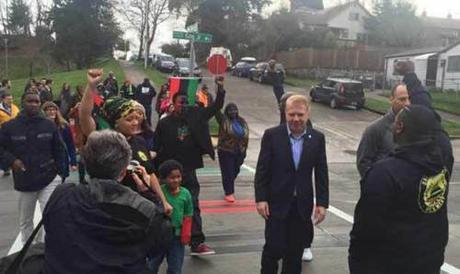It’s not like the mayor of Seattle has anything else to worry about, such as the homeless problem or citizens’ complaints of not enough police presence. But, hey, cool sidewalks!

Seattle Mayor Ed Murray (l) standing on a rainbow sidewalk that will fight crime.
Last year the City of Seattle installed painted rainbow sidewalks. As identified by a “task force”, the goal was to “to reduce the violent attacks and verbal harassment experienced by LGBTQ people.”Now a new, custom crosswalk has been installed in the city’s Central District. The new crosswalk, painted in Pan-African colors, was unveiled at the intersection of 23rd and Martin Luther King Jr. Way over the weekend, as reported by MyNorthwest.com.

City of Seattle photo
Rokea Jones of the United Hood Movement told KIRO 7 what the colors signify. “Red represents the blood of the people, black is for the people and green is for the land,” she said.The Office of Economic Development says the crosswalk celebrates the cultural heritage of the neighborhood. The Seattle Department of Transportation made the Pan-African crosswalk official by including safety signs and reflectors. Money for the crosswalks come from street-use fees.

City of Seattle photo
Excitement over custom crosswalks may fizzle out here, however. A check into the city’s Community Crosswalk Program found shows there is little interest. Neither the SDOT nor the Department of Community Development (both responsible for the program) had any records related to the program at the end of 2015.In order to get a custom crosswalk, the city suggests interested parties first review the Community Crosswalks Guidelines, which include restrictions on where crosswalks are eligible. Next, the city asks for a review of the Neighborhood Matching Fund. The neighborhood fund awards matching funds based on a neighborhood’s contribution of volunteerism, donated material, in-kind professional services or money. The city also suggests applicants have a community involvement strategy. The crosswalks cost about $25 per square foot and last three to five years.
DCG

